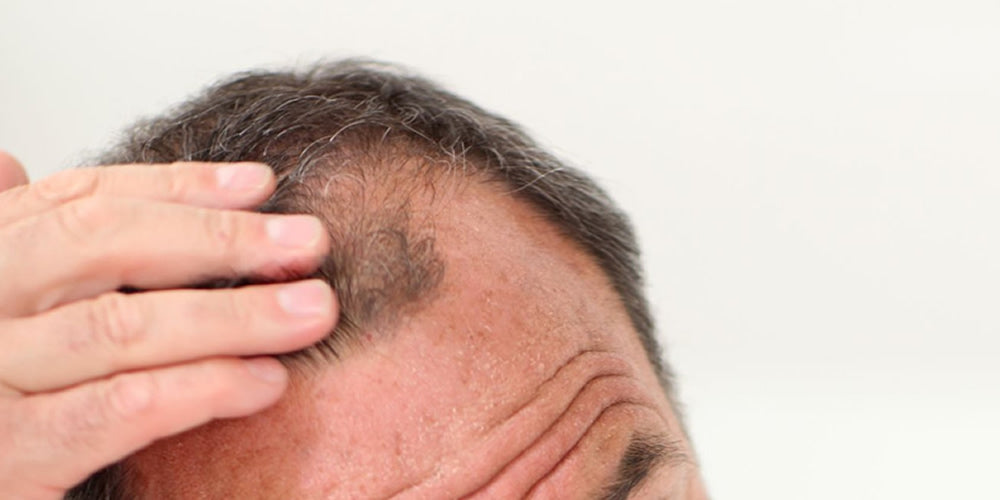What is Male Pattern Baldness?
07Jun

Welcome back to the Reseed blog which will tell you everything you every wanted to know about hair and more!
This week we will be talking about male pattern baldness; the causes, symptoms and treatments that are available.
Last week we touched on the hair’s structure and life cycle; now let’s discuss the different events that can cause a disruption to a healthy hair growth cycle and ultimately lead to thinning and hair loss.
As you know, we each have an estimated 100,000 hairs on our heads, in some cases this number can be reduced for a variety of reasons such as:
Decreased function of the hair matrix cells
This is when the hair matrix cells stop producing the hair shaft, and the inner and outer root sheaths at a normal rate which prevents the hair from dividing normally. In healthy hair hormones released from the dermal papilla control the migration of stem cells to the hair matrix cells where they divide and differentiate.
What can I do? Apigenin, which is an antioxidant and anti-inflammatory helps increase the proliferation of the dermal papilla cells. Arnica Montana is a homeopathic treatment that is used to treat hair and scalp conditions. It is claimed that the oil strengthens hair and combats premature hair loss. Isochrysis Galbana extract is a microalgae that prevents thinning and has been clinically shown to increase anagen hair by 10.5% and telogen hair by 11.7%.
Bad blood circulation
For healthy hair growth it is essential to have good blood circulation to supply essential nutrients to the roots.
What can I do? Any form of exercise is always a good way to get the blood pumping. You could also try regular head massages to help increase the blood flow to the follicle. Vitamins B3, B5, B6 and Rehmannia Chinensis Root are known to stimulate and accelerate blood circulation.
Increased sensitivity of the androgenic hormones
This basically means follicles that are sensitive to androgens. This form of sensitivity is usually inherited, so even normal amounts of circulating androgens can cause hair loss. Although androgens are present in both sexes, it is more recognised as a male hormone due to the higher levels that are found in men.
What can I do? There are topical and oral treatments that can help reduce the effect androgens have on the hair follicles. Look for products that contain the following ingredients: Apigenin, Saw Palmetto, Nettle, Arnica extract, B vitamins and Isochrysis Galbana.
Overactive sebaceous glands
A build-up of excess oil on the scalp can lead to dandruff which suffocate the hair follicle and inhibit the natural growth cycle.
What can I do? Vitamins B3, B5, B6, Zinc, Magnesium and Manganese Gluconate help to regulate and supress excess sebum secretion. Look for food supplements or products that contain these vitamins.
Stress
The everyday stresses that we all experience is highly unlikely to make a difference to your normal hair functions however, a significant stress can spark a change in the body’ physiological functions. Stress related hair loss doesn’t occur immediately, and usually presents itself between 6 to 12 months later due to the hair’s growth cycle. Although this form of hair loss isn’t usually permanent, the psychological impact it can have on the sufferer can lead to feelings of ugliness, low self-esteem and in some cases, trigger a body dysmorphic disorder.
It’s not all bad news; once the initial stress has been resolved, the hair usually grows back and the normal hair growth cycle is resumed.
What can I do? If you find that you are getting more stressed than usual, why not try joining a yoga class or practicing meditation and relaxation methods to help you manage your stress levels. Rosemary, which is probably more recognised for its culinary uses is also an antidepressant and is high in iron, calcium and vitamin B6 which will help to keep the blues away.
Medication and medicinal treatments
Taking medication and undergoing medical treatments can have unwanted side effects that disrupt the scalps normal balance and hair growth cycle. There are two types of hair loss that can be induced by mediations; telogen effluvium and anagen effluvium.
Telogn effluvium is the more common of the two and is generally noted within two to four months after taking the medication. This causes the hair follicles to go into the telogen (resting phase), and fall out early.
Anagen effluvium can affect other body hairs including eyelashes and eyebrows, and is often associated with chemotherapy drugs which can cause the user to experience a loss of all their bodily hair. Anagen effluvium occurs at the anagen (growth phase) which stops the matrix cells from dividing normally and is noted within just a few days or weeks after taking the medication.
What can I do? The hair’s growth life cycle usually resumes once treatment or medication ends. Remember, it can take between 6-12 months before the hair begins its growth cycle. However, there are still measures that you can take to help speed up the process and encourage healthy hair growth. B vitamins, Isochrysis Galbana extract which helps prevent hair thinning; Saw Palmetto and Maca Root can all help to stimulate hair growth.
Hair Myth: Bald men are more virile because they have higher testosterone levels.
Hair Fact: Bald men haven’t got more testosterone than other men; the truth is their follicles are just more sensitive the hormones.
This week we will be talking about male pattern baldness; the causes, symptoms and treatments that are available.
Last week we touched on the hair’s structure and life cycle; now let’s discuss the different events that can cause a disruption to a healthy hair growth cycle and ultimately lead to thinning and hair loss.
As you know, we each have an estimated 100,000 hairs on our heads, in some cases this number can be reduced for a variety of reasons such as:
Decreased function of the hair matrix cells
This is when the hair matrix cells stop producing the hair shaft, and the inner and outer root sheaths at a normal rate which prevents the hair from dividing normally. In healthy hair hormones released from the dermal papilla control the migration of stem cells to the hair matrix cells where they divide and differentiate.
What can I do? Apigenin, which is an antioxidant and anti-inflammatory helps increase the proliferation of the dermal papilla cells. Arnica Montana is a homeopathic treatment that is used to treat hair and scalp conditions. It is claimed that the oil strengthens hair and combats premature hair loss. Isochrysis Galbana extract is a microalgae that prevents thinning and has been clinically shown to increase anagen hair by 10.5% and telogen hair by 11.7%.
Bad blood circulation
For healthy hair growth it is essential to have good blood circulation to supply essential nutrients to the roots.
What can I do? Any form of exercise is always a good way to get the blood pumping. You could also try regular head massages to help increase the blood flow to the follicle. Vitamins B3, B5, B6 and Rehmannia Chinensis Root are known to stimulate and accelerate blood circulation.
Increased sensitivity of the androgenic hormones
This basically means follicles that are sensitive to androgens. This form of sensitivity is usually inherited, so even normal amounts of circulating androgens can cause hair loss. Although androgens are present in both sexes, it is more recognised as a male hormone due to the higher levels that are found in men.
What can I do? There are topical and oral treatments that can help reduce the effect androgens have on the hair follicles. Look for products that contain the following ingredients: Apigenin, Saw Palmetto, Nettle, Arnica extract, B vitamins and Isochrysis Galbana.
Overactive sebaceous glands
A build-up of excess oil on the scalp can lead to dandruff which suffocate the hair follicle and inhibit the natural growth cycle.
What can I do? Vitamins B3, B5, B6, Zinc, Magnesium and Manganese Gluconate help to regulate and supress excess sebum secretion. Look for food supplements or products that contain these vitamins.
Stress
The everyday stresses that we all experience is highly unlikely to make a difference to your normal hair functions however, a significant stress can spark a change in the body’ physiological functions. Stress related hair loss doesn’t occur immediately, and usually presents itself between 6 to 12 months later due to the hair’s growth cycle. Although this form of hair loss isn’t usually permanent, the psychological impact it can have on the sufferer can lead to feelings of ugliness, low self-esteem and in some cases, trigger a body dysmorphic disorder.
It’s not all bad news; once the initial stress has been resolved, the hair usually grows back and the normal hair growth cycle is resumed.
What can I do? If you find that you are getting more stressed than usual, why not try joining a yoga class or practicing meditation and relaxation methods to help you manage your stress levels. Rosemary, which is probably more recognised for its culinary uses is also an antidepressant and is high in iron, calcium and vitamin B6 which will help to keep the blues away.
Medication and medicinal treatments
Taking medication and undergoing medical treatments can have unwanted side effects that disrupt the scalps normal balance and hair growth cycle. There are two types of hair loss that can be induced by mediations; telogen effluvium and anagen effluvium.
Telogn effluvium is the more common of the two and is generally noted within two to four months after taking the medication. This causes the hair follicles to go into the telogen (resting phase), and fall out early.
Anagen effluvium can affect other body hairs including eyelashes and eyebrows, and is often associated with chemotherapy drugs which can cause the user to experience a loss of all their bodily hair. Anagen effluvium occurs at the anagen (growth phase) which stops the matrix cells from dividing normally and is noted within just a few days or weeks after taking the medication.
What can I do? The hair’s growth life cycle usually resumes once treatment or medication ends. Remember, it can take between 6-12 months before the hair begins its growth cycle. However, there are still measures that you can take to help speed up the process and encourage healthy hair growth. B vitamins, Isochrysis Galbana extract which helps prevent hair thinning; Saw Palmetto and Maca Root can all help to stimulate hair growth.
Hair Myth: Bald men are more virile because they have higher testosterone levels.
Hair Fact: Bald men haven’t got more testosterone than other men; the truth is their follicles are just more sensitive the hormones.
